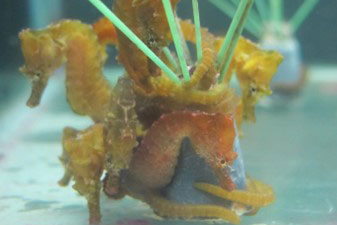
The HIPPOSAVE project allowed the researchers to learn more about the environmental and habitat requirements of this species in the Ria Formosa lagoon (Portugal), where the numbers have fallen by more than 90% in a decade.
For more than a decade, the Resources, Restoration, Connectivity and Climate research group of the Centre of Marine Sciences (CCMAR) of the University of Algarve has focused on the wild seahorse populations in the Ria Formosa and on breeding seahorses in captivity. This project pinpointed factors that reduce the resilience of the seahorses; these include indirect anthropogenic impacts such as habitat degradation, by-catch in fishing nets, and underwater noise, as well as natural impacts such as silting. In recent years, illegal fishing directly targeting seahorses has also been identified.
This project aimed to evaluate the current status of the two seahorse species in the Ria Formosa (Hippocampus guttulatus and H. hippocampus), monitor the conservation relevance of two recently created Marine Protected Areas, and improve degraded habitats through the combined use of seagrass transplants and artificial holdfasts. Beneficiaries also aimed to breed seahorses in captivity to be released under controlled conditions in the Marine Protected Areas, as well as promote “ocean literacy” among local stakeholders to help conserve seahorse populations and safeguard local natural resources.
- Project locations
- Portugal
- Overall budget
- €517 746
- EU contribution
- €388 30975% of the overall budget
- Project website
- UAlg Hippocampus
Results
Monitoring wild seahorse populations in terms of both present status and trends for the future. Low abundances were observed in 2020 and 2021, while monitoring showed a slight recovery of the populations in 2022.
Creation of small MPAs, which have resulted in local increases in seahorse abundance. This confirms that a network of MPAs is not only useful but necessary and would have a future beneficial effect on the local conservation of seahorses.
Developing environmentally friendly artificial structures to be used for habitat recovery. Their use in the wild within one of the MPAs was accompanied by a significant increase in seahorse abundance, thus providing information for future conservation actions.
A genetic survey confirmed that there is still a good genetic diversity, despite the recent decrease in the populations.
The captive breeding programme has been successful, and re-stocking with captive-bred seahorses confirmed that seahorses benefit from a protected environment within the MPAs.
Seahorses are flagship species whose sensitivity is fully representative of their environment. They are good indicators of ecosystem quality. Seahorse conservation actions can therefore be extended to their habitat and to the overall ecosystem, thus benefiting local biodiversity. In turn, improvements in local biodiversity directly benefit the area and those who use it either professionally or for leisure.
Contact
Jorge Palma
- Name
- Jorge Palma
- Organisation
- Algarve University
- jpalma
 ualg [dot] pt
ualg [dot] pt
